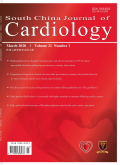- 钛学术文献服务平台 \
- 学术期刊 \
- 医药卫生期刊 \
- 内科学期刊 \
- 岭南心血管病杂志(英文版)期刊 \
Application of permanent left bundle branch pacing in patients with bradycardia after cardiac surgery
Application of permanent left bundle branch pacing in patients with bradycardia after cardiac surgery
基本信息来源于合作网站,原文需代理用户跳转至来源网站获取
摘要:
Background The study was to access the feasibility and effectiveness of permanent left bundle branch pacing (LBBP) in patients with bradycardia after cardiac surgery,in comparison with conventional right ventricular outflow tract septal pacing (RVOSP).Methods A total of 50 patients with cardiac surgery who underwent permanent pacemaker implantation (PPI) were enrolled,21 patients underwent LBBP (LBBP group) and 29 patients underwent RVOSP (RVOSP group).Pacing electrical parameters,QRS duration (QRSd),echocardiographic measurements,lead and device related complications were obtained at procedure and during follow-ups.Results There were no statistically significant differences between the LBBP group and the RVOSP group at procedure and at the twelfth month's follow-up in pacing thresholds (0.64±0.16 V vs.0.63±0.22 V) and (0.91±0.28 V vs.0.85±0.20 V),R-wave amplitude (16.68±4.52 mV vs.15.09±4.53 mV) and (14.41±8.65 mV vs.12.65±6.17 mV),pacing impedances (719.24±152.65 Ω vs.639.13±177.04 Ω) and (534.01±96.92 Ω vs.499.18±77.87 Ω).But the average ventricular pacing percentage (VP%) at the first month's follow-up (81.96±32.06% vs.58.37±42.96%) and at the twelfth month's follow-up (84.65±35.84% vs.53.57±38.47%) showed significant difference between two groups (P<0.05);The LBBP group produced narrower QRSd (121.13 ± 23.91 ms) than the RVOSP group (158.00±9.69 ms) (P=0.011).There were no significant differences between the LBBP group and the RVOSP group at pre-procedure and at the twelfth month's follow-up in echocardiographic parameters,which included left ventricular end-diastolic dimension (LVEDD) (48.76± 7.08 mm vs.47.34± 6.91 ram) and (50.58 ± 10.33 mm vs.45.97±7.11 mm),left ventricular ejection fraction (LVEF) (58.33±12.64% vs.61.50±8.40%) and (55.85±16.35% vs.61.50±10.52%),and area of tricuspid regurgitation (TR) (2.79±3.65 cm2 vs.2.85±2.26 cm2) and (3.09±2.34 cm2 vs.2.95± 1.92 cm2).No lead and device related complication was observed during follow-ups.Conclusions LBBP is feasible and effective in patients with bradycardia after cardiac surgery.LBBP produces narrow QRSd,which may be a preferred pacing strategy for patients after cardiac surgery.

推荐文章
探索 After Effects 在动画专业制作中的应用
After Effects(AE)
动画制作
功能应用
动画效果
After Effects制作微课方法初探
微课
教学
After Effects
Adobe After Effect插件原理及其实现
插件
PICA
COM
Application ontology构建及SPARQL查询研究
本体
手机应用
简单协议和RDF查询语言
查询
本体描述语言
内容分析
关键词云
关键词热度
相关文献总数
(/次)
(/年)
文献信息
| 篇名 | Application of permanent left bundle branch pacing in patients with bradycardia after cardiac surgery | ||
| 来源期刊 | 岭南心血管病杂志(英文版) | 学科 | |
| 关键词 | |||
| 年,卷(期) | 2021,(1) | 所属期刊栏目 | CLINICAL STUDIES |
| 研究方向 | 页码范围 | 13-20 | |
| 页数 | 8页 | 分类号 | |
| 字数 | 语种 | 英文 | |
| DOI | |||
五维指标
引文网络
引文网络
二级参考文献 (0)
共引文献 (0)
参考文献 (14)
节点文献
引证文献 (0)
同被引文献 (0)
二级引证文献 (0)
1998(1)
- 参考文献(1)
- 二级参考文献(0)
2006(1)
- 参考文献(1)
- 二级参考文献(0)
2013(2)
- 参考文献(2)
- 二级参考文献(0)
2015(1)
- 参考文献(1)
- 二级参考文献(0)
2016(1)
- 参考文献(1)
- 二级参考文献(0)
2017(2)
- 参考文献(2)
- 二级参考文献(0)
2018(1)
- 参考文献(1)
- 二级参考文献(0)
2019(5)
- 参考文献(5)
- 二级参考文献(0)
2021(0)
- 参考文献(0)
- 二级参考文献(0)
- 引证文献(0)
- 二级引证文献(0)
引文网络交叉学科
相关学者/机构
期刊影响力
岭南心血管病杂志(英文版)
主办单位:
广东省心血管病研究所
出版周期:
季刊
ISSN:
1009-8933
CN:
44-1512/R
开本:
大16开
出版地:
广州市东川路96号二楼233室
邮发代号:
46-243
创刊时间:
2000
语种:
eng
出版文献量(篇)
771
总下载数(次)
0
总被引数(次)
177
期刊文献
相关文献
推荐文献
- 期刊分类
- 期刊(年)
- 期刊(期)
- 期刊推荐
岭南心血管病杂志(英文版)2021
岭南心血管病杂志(英文版)2020
岭南心血管病杂志(英文版)2019
岭南心血管病杂志(英文版)2018
岭南心血管病杂志(英文版)2017
岭南心血管病杂志(英文版)2016
岭南心血管病杂志(英文版)2015
岭南心血管病杂志(英文版)2014
岭南心血管病杂志(英文版)2013
岭南心血管病杂志(英文版)2012
岭南心血管病杂志(英文版)2011
岭南心血管病杂志(英文版)2010
岭南心血管病杂志(英文版)2009
岭南心血管病杂志(英文版)2008
岭南心血管病杂志(英文版)2007
岭南心血管病杂志(英文版)2006
岭南心血管病杂志(英文版)2005
岭南心血管病杂志(英文版)2004
岭南心血管病杂志(英文版)2003
岭南心血管病杂志(英文版)2002
岭南心血管病杂志(英文版)2001
岭南心血管病杂志(英文版)2000

 免费查重
免费查重










